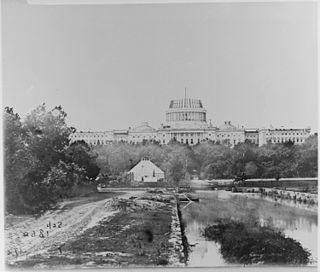
The 6th United States Congress was a meeting of the legislative branch of the United States federal government, consisting of the Senate and the House of Representatives. It met at Congress Hall in Philadelphia, Pennsylvania and in Washington, D.C. from March 4, 1799, to March 4, 1801, during the last two years of John Adams's presidency. It was the last Congress of the 18th century and the first to convene in the 19th. The apportionment of seats in House of Representatives was based on the First Census of the United States in 1790. Both chambers had a Federalist majority. This was the last Congress in which the Federalist Party controlled the presidency or either chamber of Congress.

The California State Assembly is the lower house of the California State Legislature, the upper house being the California State Senate. The Assembly convenes, along with the State Senate, at the California State Capitol in Sacramento.

The 35th United States Congress was a meeting of the legislative branch of the United States federal government, consisting of the United States Senate and the United States House of Representatives. It met in Washington, D.C. from March 4, 1857, to March 4, 1859, during the first two years of James Buchanan's presidency. The apportionment of seats in the House of Representatives was based on the Seventh Census of the United States in 1850. Both chambers had a Democratic majority.

The 70th United States Congress was a meeting of the legislative branch of the United States federal government, consisting of the United States Senate and the United States House of Representatives. It met in Washington, D.C. from March 4, 1927, to March 4, 1929, during the last two years of Calvin Coolidge's presidency. The apportionment of seats in the House of Representatives was based on the Thirteenth Decennial Census of the United States in 1910.

The 71st New York State Legislature, consisting of the New York State Senate and the New York State Assembly, met from January 4 to April 12, 1848, during the second year of John Young's governorship, in Albany.

The 81st New York State Legislature, consisting of the New York State Senate and the New York State Assembly, met from January 5 to April 19, 1858, during the second year of John A. King's governorship, in Albany.

The 83rd New York State Legislature, consisting of the New York State Senate and the New York State Assembly, met from January 3 to April 17, 1860, during the second year of Edwin D. Morgan's governorship, in Albany.

The 87th New York State Legislature, consisting of the New York State Senate and the New York State Assembly, met from January 5 to April 23, 1864, during the second year of Horatio Seymour's second tenure as Governor of New York, in Albany.

The 89th New York State Legislature, consisting of the New York State Senate and the New York State Assembly, met from January 2 to April 20, 1866, during the second year of Reuben E. Fenton's governorship, in Albany.

The 137th New York State Legislature, consisting of the New York State Senate and the New York State Assembly, met from January 7 to May 20, 1914, while Martin H. Glynn was Governor of New York, in Albany.
The 118th United States Congress is the next meeting of the legislative branch of the United States federal government, composed of the United States Senate and the United States House of Representatives. It is scheduled to meet in Washington, D.C., from January 3, 2023, to January 3, 2025, during the third and fourth years of Joe Biden’s presidency. The elections of November 2022 will decide control of both houses.

The 8th Arizona State Legislature, consisting of the Arizona State Senate and the Arizona House of Representatives, was constituted from January 1, 1927 to December 31, 1928, during the first and second years of George W. P. Hunt's sixth tenure as Governor of Arizona, in Phoenix. The number of senators remained constant at 19, while the number of representatives increased from 47 to 52. The Democrats held large majorities in both houses.

The 9th Arizona State Legislature, consisting of the Arizona State Senate and the Arizona House of Representatives, was constituted from January 1, 1929 to December 31, 1930, during the first and second years of John Calhoun Phillips's tenure as Governor of Arizona, in Phoenix. The number of senators remained constant at 19, while the number of representatives increased from 52 to 54. The Democrats held large majorities in both houses, although the Republicans made significant inroads in the House.
The Twelfth Wisconsin Legislature convened from January 12, 1859, to March 21, 1859, in regular session.
The Thirteenth Wisconsin Legislature convened from January 11, 1860, to April 2, 1860, in regular session.
The Fourteenth Wisconsin Legislature convened from January 9, 1861, to April 17, 1861, in regular session. The legislature re-convened in special session from May 15, 1861, to May 27, 1861, at the request of Wisconsin Governor Alexander Randall, to approve funding for a brigade of volunteers for the American Civil War.
The Fifteenth Wisconsin Legislature convened from January 8, 1862, to April 7, 1862, in regular session, and re-convened from June 3, 1862, through June 17, 1862. The legislature further convened in a special session from September 10, 1862, through September 26, 1862.

The Sixteenth Wisconsin Legislature convened from January 14, 1863, to April 2, 1863, in regular session.

The Seventeenth Wisconsin Legislature convened from January 13, 1864, to April 4, 1864, in regular session.

The Eighteenth Wisconsin Legislature convened from January 11, 1865, to April 10, 1865, in regular session.








